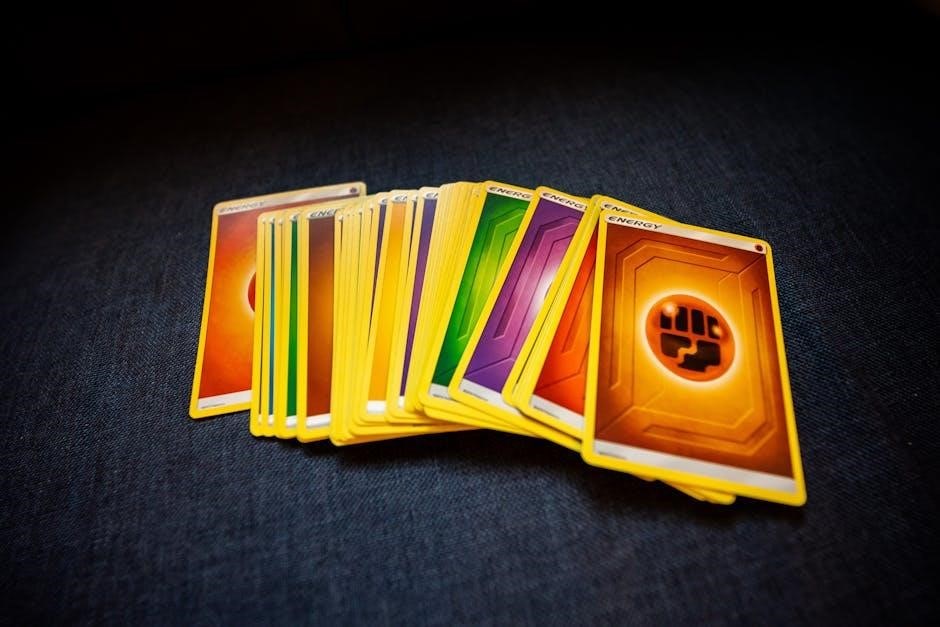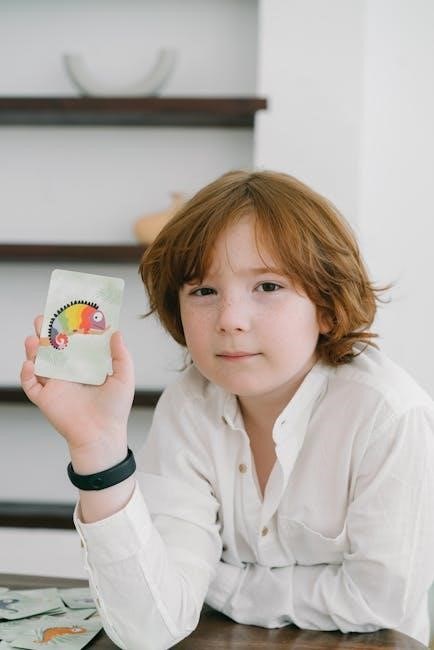The Garbage Card Game is a simple, family-friendly card game with easy-to-follow rules, perfect for 2-4 players. It involves strategic thinking and a standard deck of cards. Players aim to replace face-down cards with face-up ones in sequential order, creating a fun and engaging experience for all ages.
1.1 Overview of the Game
The Garbage Card Game is a straightforward, engaging card game suitable for 2-4 players. It involves a standard deck of 52 cards, with players receiving 10 face-down cards each. These cards are arranged in two rows of five, forming a personal layout. The remaining cards are placed face-down in the center as a draw pile. The objective is to be the first player to flip all 10 cards face-up in sequential order from Ace to 10. The game emphasizes strategic thinking, quick reflexes, and a bit of luck, making it a fun and accessible experience for players of all ages.
1.2 Popularity and Ease of Play
Gaining widespread popularity due to its simplicity, the Garbage Card Game is favored for its ease of play and quick setup. Players of all ages can easily grasp the rules, making it ideal for family gatherings and casual game nights. Its straightforward nature ensures that even newcomers can join in without prior experience. The game’s portability and minimal equipment requirements further enhance its appeal, allowing it to be played virtually anywhere. This accessibility contributes to its enduring popularity and makes it a go-to option for those seeking a light-hearted, entertaining experience.
Setup and Initial Rules
The Garbage Card Game setup involves dealing 10 face-down cards to each player, arranging them in two rows of five, and placing the remaining cards in a draw pile.
2.1 Number of Players and Decks Needed
The Garbage Card Game is designed for 2 to 4 players, ensuring dynamic interaction. A standard deck of 52 cards is typically used, though multiple decks may be needed for larger groups. Each player receives an equal number of cards, ensuring fair play. The game’s flexibility allows it to adapt to different player counts, making it accessible for various gatherings. The rules remain consistent regardless of the number of participants, maintaining a balanced and enjoyable experience for everyone involved.
2.2 Dealing the Cards
To begin, the dealer shuffles the deck and deals 10 face-down cards to each player, one at a time. Players should not look at their cards during this process. Once all cards are dealt, players arrange their 10 cards in two rows of five, creating their personal game layout. The remaining cards are placed face-down in the center of the playing area, forming the draw pile. This setup ensures the game starts fairly and evenly for all participants, with each player having the same number of cards to work with.
2.3 Arranging the Cards
After dealing, each player arranges their 10 face-down cards into two rows of five cards each. This creates a personal game layout. Players should not look at their cards during this step. The remaining cards are placed face-down in the center, forming the draw pile. This setup ensures the game begins with a structured and organized layout, allowing players to focus on replacing their face-down cards during gameplay. The arrangement is a critical step, as it sets the foundation for the rest of the game and ensures fairness for all participants.
Objective of the Game
The objective is to be the first player to replace all face-down cards with face-up cards in sequential order from Ace to 10. The game ends when a player achieves this, making them the winner.
3.1 Winning the Game
To win, a player must replace all 10 face-down cards with face-up cards in sequential order from Ace to 10. The first player to achieve this layout wins immediately. The game ends as soon as a player completes the sequence, and no further turns are taken. Winning requires strategic card management and quick thinking to outpace opponents. The goal is to be the first to flip all cards face-up in the correct order, making it a race against other players. The winner is declared as soon as their sequence is complete.
3.2 Understanding the Layout
The game layout consists of two rows of five face-down cards per player, forming a personal grid. The remaining cards are placed face-down in the center as the draw pile. Each player arranges their 10 cards in two rows of five, creating a structured setup. Face-down cards must be replaced with face-up cards in sequential order (Ace to 10). The layout helps players track progress and strategize replacements. This organized arrangement is key to achieving the game’s objective, making it visually clear when a player is close to winning. The layout ensures clarity and fairness for all participants.

Gameplay Mechanics
Players draw cards, replacing face-down cards with face-up ones in sequential order (Ace-10). Special cards add excitement, while penalties may disrupt progress, enhancing strategic play.
4.1 Drawing Cards
Players take turns drawing cards from the draw pile to replace face-down cards in their layout. Each player starts with 10 face-down cards arranged in two rows of five. The remaining cards form the draw pile, placed face-down in the center. On their turn, a player draws one card from the draw pile and uses it to replace a face-down card in their layout. The goal is to replace all face-down cards with face-up cards in sequential order (Ace through 10). Drawing cards is the primary mechanic driving the game forward, as it allows players to progress toward completing their sequence.
4.2 Replacing Face-Down Cards
Players replace face-down cards by drawing from the draw pile or using cards from their hand. When a card is drawn, it can replace a face-down card in their layout, turning it face-up. The replacement must follow the sequential order (Ace to 10) in each row. Only one card can be replaced per turn, and players cannot rearrange cards once they are face-up. The goal is to be the first to have all 10 cards face-up in the correct order, making strategic card replacement a key part of the game. This mechanic ensures a balance of luck and strategy.
4.3 Role of Special Cards
In the Garbage Card Game, special cards like Jokers or Wilds are not traditionally part of the rules but can be introduced as variations. If included, Jokers could act as Wild cards, allowing players to replace any face-down card. Face cards (Jack, Queen, King) might be used as penalty cards, forcing a player to draw extra cards or skip a turn. These special cards can add excitement and unpredictability, making the game more dynamic and challenging. Their inclusion depends on optional rule variations agreed upon by players before the game begins. This flexibility enhances the game’s appeal.

Advanced Rules and Strategies

Advanced strategies involve optional rule variations, such as penalties for busted cards and multiple rounds for scoring. Players can adapt tactics to enhance their chances of winning.
5.1 Optional Rule Variations
Optional rule variations can enhance gameplay by introducing new challenges. For instance, penalties for “busted” cards or multiple rounds with cumulative scoring add complexity. Some players choose to decrease the number of dealt cards for winners in subsequent rounds, while others introduce a “silly” rule, like penalizing players for specific actions, to make the game more entertaining. These variations allow players to customize the game to suit their preferences, making it more dynamic and engaging for diverse groups of players. Such tweaks ensure the game remains fresh and exciting for repeated play.
5.2 Penalties and Busted Cards
In the Garbage Card Game, penalties and busted cards add an extra layer of strategy. A “busted” card occurs when a player cannot place a card on their layout, forcing them to draw a penalty card. This rule ensures players stay attentive and strategic. If a player draws a penalty card, they must resolve it immediately, which could include drawing additional cards or losing a turn. Penalties can significantly impact a player’s progress, making the game more challenging and unpredictable. Managing penalties effectively is key to winning, as they can delay a player’s ability to flip all their cards face-up.
5.3 Multiple Rounds and Scoring
The Garbage Card Game can be played in multiple rounds, with scoring tracking players’ progress. Each round ends when one player successfully flips all their cards face-up. Points are awarded based on the number of face-down cards remaining in a player’s layout. Players with fewer face-down cards receive lower scores. In subsequent rounds, the winner of the previous round starts with one less card, giving them an advantage. This scoring system encourages strategic play and rewards efficiency, making the game enjoyable for multiple rounds while maintaining a competitive edge among players. The goal is to accumulate the lowest score possible over several rounds.

Variations for Different Player Counts
The Garbage Card Game adapts to different player counts by adjusting deck size and layout. For 2 players, each receives 10 cards. With more players, additional decks may be used to ensure each player has enough cards. The basic rules remain consistent, but strategies may vary based on the number of participants, allowing the game to remain dynamic and engaging for any group size.
6.1 Rules for 2 Players
The Garbage Card Game for two players follows the same core rules but with a few adjustments for a more competitive experience. Each player receives 10 face-down cards, arranged in two rows of five. The remaining cards form the draw pile. Players take turns drawing cards and replacing face-down cards with face-up ones in sequential order from Ace to 10. The first player to flip all their cards face-up wins. This setup ensures a fast-paced and strategic game, ideal for head-to-head competition. The simplicity of the rules makes it accessible while maintaining excitement for two players.
6.2 Adjustments for 3-4 Players
For 3-4 players, the Garbage Card Game remains engaging with minor rule tweaks. Each player still receives 10 face-down cards, arranged in two rows of five. The draw pile is shared, and players take turns drawing and replacing cards. The objective remains the same: flipping all cards face-up in order from Ace to 10. With more players, the game becomes more dynamic, as players can strategize or even form temporary alliances. The competitive nature intensifies, making it a lively and enjoyable experience for larger groups while keeping the core rules intact and easy to follow for everyone involved.
The Garbage Card Game is a simple yet engaging activity that enhances social interaction and cognitive skills. Ideal for family game nights, it fosters fun and learning for all ages.
7.1 Final Thoughts on the Game
The Garbage Card Game is a delightful, easy-to-learn activity that combines strategy and luck. Its straightforward rules make it accessible to all ages, fostering social interaction and fun. Players enjoy the challenge of flipping cards in sequence, while the competitive nature keeps everyone engaged. The game’s simplicity allows it to be played anywhere, making it a great addition to family gatherings or casual meetups. Its ability to enhance cognitive skills like sequencing and strategic thinking adds value beyond mere entertainment. Overall, it’s a timeless, versatile game that brings people together and offers lasting enjoyment.
7.2 Social and Cognitive Benefits
The Garbage Card Game fosters social interaction, encouraging communication and teamwork while promoting healthy competition. It enhances cognitive skills like memory, attention, and problem-solving, as players strategically plan their moves. The game also improves sequencing abilities and numerical understanding, particularly in arranging cards from Ace to 10. Additionally, it builds resilience and adaptability, as players learn to handle unexpected outcomes. Its inclusive nature makes it accessible to diverse age groups, creating a shared experience that strengthens social bonds and cognitive development in a fun and engaging way.